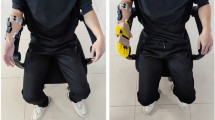Abstract
The main goal of this paper is to design an electromyogram (EMG) pattern classifier which is robust to muscular fatigue effects for human-machine interaction. When a user operates some machines such as a PC or a powered wheelchair using EMG-based interface, muscular fatigue is generated by sustained duration time of muscle contraction. Therefore, recognition rates are degraded by the muscular fatigue. In this paper, an important observation is addressed: the variations of feature values due to muscular fatigue effects are consistent for sustained duration time. From this observation, a robust pattern classifier was designed through the adaptation process of hyperboxes of Fuzzy Min-Max Neural Network. As a result, significantly improved performance is confirmed.
Preview
Unable to display preview. Download preview PDF.
Similar content being viewed by others
References
Collins COBUILD Advanced Learner’s English Dictionary, 4th edn. (2003)
Bigland-Ritchie, B., Jones, D.A., Hosking, G.P., Edwards, R.H.: Central and peripheral fatigue in sustained maximum voluntary contractions of human quadriceps muscle. Journal of Clinical Science and Molecular Medicine 54(6), 609–614 (1978)
Kiryu, T., Morishiata, M., Yamada, H., Okada, M.: A muscular fatigue index based on the relationships between superimposed M wave and preceding background activity. IEEE Transactions on Biomedical Engineering 45(10), 1194–1204 (1998)
Bonato, P., Roy, S.H., Knaflitz, M., de Luca, C.J.: Time-frequency parameters of the surface myoelectric signal for assessing muscle fatigue during cyclic dynamic contractions. IEEE Transactions on Biomedical Engineering 48(7), 745–753 (2001)
Park, E., Meek, S.G.: Fatigue compensation of the electromyographic signal for prosthetic control and force estimation. IEEE Transactions on Biomedical Engineering 40(10), 1019–1023 (1993)
Winslow, J., Jacobs, P.L., Tepavac, D.: Fatigue compensation during FES using surface EMG. Journal of Electromyography and Kinesilogy 13(6), 555–568 (2003)
Chen, J.-J.J., Yu, N.-Y.: The validity of stimulus-evoked EMG for studying muscle fatigue characteristics of paraplegic subjects during dynamic cycling movement. IEEE Transactions on Rehabilitation Engineering 5(2), 170–178 (1997)
Knox, R.R., Brooks, D.H., Manolakos, E., Markogiannakis, S.: Time-series based features for EMG pattern recognition: Preliminary results. In: Bioengineering Conference, Proceedings of the IEEE Nineteenth Annual Northeast, March 18-19 (1993)
Boostani, R., Moradi, M.H.: Evaluation of the forearm EMG signal features for the control of a prosthetic hand. Journal of Physiological Measurement 24, 309–319 (2003)
Simpson, P.: Fuzzy min-max neural networks - Part 1: Classification. IEEE Transactions on Neural Networks 3, 776–786 (1992)
Author information
Authors and Affiliations
Editor information
Editors and Affiliations
Rights and permissions
Copyright information
© 2006 Springer-Verlag Berlin Heidelberg
About this paper
Cite this paper
Song, JH., Jung, JW., Bien, Z. (2006). Robust EMG Pattern Recognition to Muscular Fatigue Effect for Human-Machine Interaction. In: Gelbukh, A., Reyes-Garcia, C.A. (eds) MICAI 2006: Advances in Artificial Intelligence. MICAI 2006. Lecture Notes in Computer Science(), vol 4293. Springer, Berlin, Heidelberg. https://doi.org/10.1007/11925231_114
Download citation
DOI: https://doi.org/10.1007/11925231_114
Publisher Name: Springer, Berlin, Heidelberg
Print ISBN: 978-3-540-49026-5
Online ISBN: 978-3-540-49058-6
eBook Packages: Computer ScienceComputer Science (R0)




